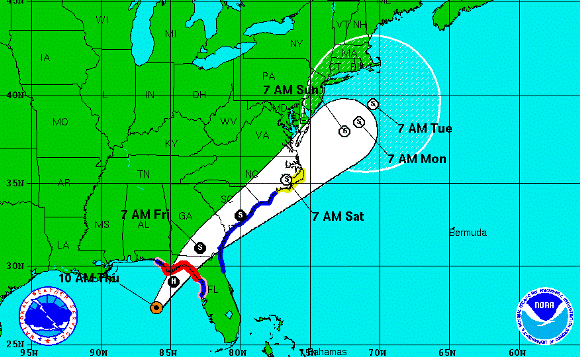Hermine
Status: Closed
| Type of posting | Posting date(EST): | Summary | Downloads |
|---|---|---|---|
| Landfall | 9/2/2016 8:05:00 AM |
|
|
| Pre-Landfall 1 | 9/1/2016 12:30:00 PM |
|
Pre-Landfall 1 | Summary
Posting Date: September 1, 2016, 12:30:00 PM
With a minimum central pressure of 989 mb and maximum sustained wind speed of 70 mph, Tropical Storm Hermine is moving north-northeast at 14 mph and is forecast to become a Category 1 hurricane by the time it makes landfall on Florida’s coast later today/early tomorrow. Heavy rain is already impacting parts of the Big Bend, which includes counties of the Florida Panhandle east of the Apalachicola River, and will continue today prior to landfall. Coastal areas are marshy in this region. Hurricane warnings are in effect for all coastal areas in the Big Bend, as well as inland counties along I-10 from Liberty County to Madison County, including Tallahassee; tropical storm warnings and hurricane watches are in effect for coastal areas from the Anclote River north through the Suwanee River.

Five-day track of Hermine. (Source: NOAA)
Exposure at Risk
Among single-family homes, wood frame is the most common construction type, although masonry is also common in Florida. The foundations of single-family homes are often a concrete crawl space, slab-on-grade, or (particularly in older wood frame houses) spread concrete footings. Florida has a relatively small percentage of basements, but as Hermine tracks north, basement flooding could be more of an issue. The exterior walls of wood frame homes can be finished with stucco, wood siding or shingles, vinyl, or aluminum cladding. Interior walls in older homes are usually finished with plaster; in newer ones they are usually finished with gypsum board.
In general, masonry houses are better able to withstand high winds than those made of wood. When masonry is used as the exterior wall material, the walls are normally constructed to full height. Then wood floors and the roof are framed into the masonry, resulting in continuous exterior walls and an overall strong structural frame. Such a structure is more resistant to hurricane winds and the impact of wind-borne debris as compared to wood frame buildings. A masonry building with a slab foundation is also more resistant to water pressure and buoyancy forces compared to wood frame buildings.
Large, high-value homes generally exhibit a high quality of construction, often with sophisticated engineering input and often with secondary risk mitigation features. They also tend to be well maintained. They may feature complex architecture with elaborate roof geometries containing multiple gable ends and corners, which tend to mitigate wind loads.
Expected Damage
Inundation caused by storm surge is expected to begin this afternoon in Big Bend and to become deep and widespread as Hermine moves through the area. Structural damage to some homes and businesses is expected, as well as a weakening of some foundations caused by heavy rain and surge, with some homes removed from their foundations entirely. Roads and bridges, including escape routes, could also get washed out, leading to closures.
Hermine’s winds are expected to cause damage to roofing and siding materials, porches, awnings, carports, and sheds. Mobile homes, especially those that are unanchored, could experience significant wind damage, and unsecured, lightweight objects could become airborne and cause damage as projectiles, particularly to windows, which could allow water into structures. Large trees could snap or be uprooted, falling on power lines and causing outages. Small craft could break away from their moorings and become beached or damage other craft. Damage to marinas, docks, boardwalks, and piers in the area affected is expected.